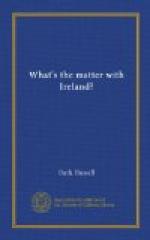Next day at the alley of the employment bureau, I met the little girl of the day before. She said a little dully:
“Well, I took—shirt-making—Edinburgh.”
Instead of migrating, a girl may marry. But her husband in most cases can’t make enough money to support a family. To keep an average family of five, just going, on food alone, costs $370 a year. Some farm hands get only $100. An average unskilled worker obtains $260 a year. An organized unskilled worker receives $367, and an organized skilled worker, $539. Therefore, if a girl marries, she has not only to bear children but to go out to work beside. Their constant toil makes the women of Ireland something less than well-cared-for slaves.
Take the mother in Dublin. In Dublin there have long been too many casual laborers. One-third of Dublin’s population of 300,000 are in this class. Now, while wages for some sorts of casual labor like dock work increased during the war, it has become almost impossible for Dublin laborers to get a day’s job. For the unemployed are flocking for the good wages from the four fields of Ireland. On the days the man is out of work the woman must go out to wash or “char.” I understood these conditions better after I spent a night in a typical one-room home in the dockers’ quarters near the Liffey.
Widow Hannan was my hostess. The widow is a strong, black-haired young woman who took an active part in the rebellion of 1916, and whose husband was killed fighting under James Connolly. We slept in the first floor front. In with the widow lay her three children, and in the cot catty-corner from the bed I was bunked. Just when the night air was thinning to gray there was a shattering rap on the ground-level window. The half-dressed young factory daughter clambered over the others and ripped down the rain coat that served as a night-time window curtain. Against the square-paned window was hunched a forward-shouldered woman.
As she was being beckoned to the door, I rose, and to do my hair had to wedge myself in between the breakfast-table and the filmy mirror that hung among the half-tone pictures of the rebels of 1916. On the iron mantel, gray with coal dust, there was a family comb.
“God save all here,” said the neighbor entering. “Mary, himself’s had no work for four days. Keep the young ones out of the grate for me. I’ve got to go out washing.”
“My sister-in-law has a husband and seven children to support,” said the widow in explanation to me. “During the war, he could do with her going out just once in a while—now it’s all the time.” Then to the sister-in-law: “I’ve a wash myself today.”
The big shoes that must once have belonged to the visitor’s man, hit the floor loosely as she walked slowly out. Then as lodger I was given the only chair at the breakfast-table. The mother and girl sat at a plank bench and supped their tea from their saucerless cups. As there was no place else to sit, the children took their bread and jam as they perched on the bed, and when they finished, surreptitiously wiped their fingers on the brown-covered hay mattress. Before we were through, they had run to the street and back to warm their cold legs inside the fender till the floor was tracked with mud from the street, ashes from the grate, and bits of crumbled bread.




